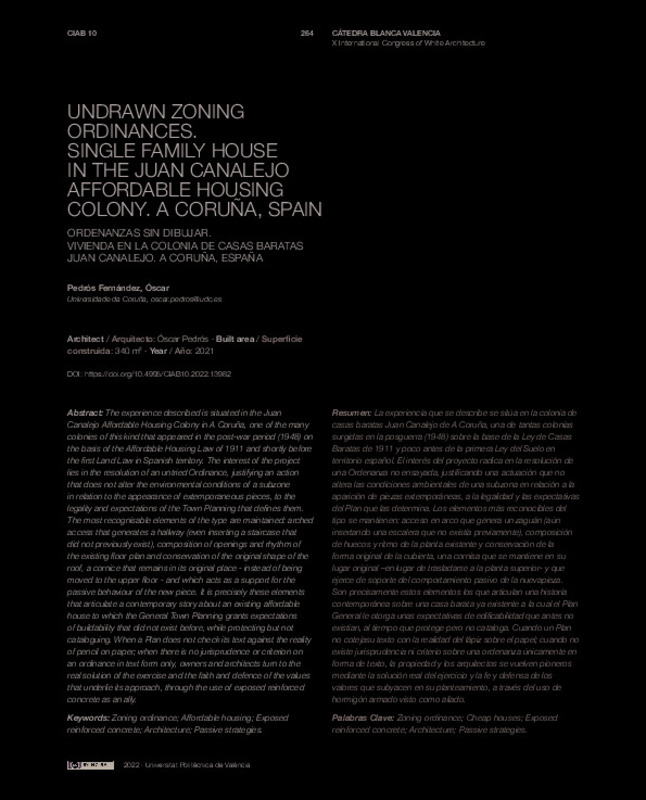|
Resumen:
|
[EN] The experience described is situated in the Juan
Canalejo Aff ordable Housing Colony in A Coruña, one of the many
colonies of this kind that appeared in the post-war period (1948) on
the basis of the Aff ordable ...[+]
[EN] The experience described is situated in the Juan
Canalejo Aff ordable Housing Colony in A Coruña, one of the many
colonies of this kind that appeared in the post-war period (1948) on
the basis of the Aff ordable Housing Law of 1911 and shortly before
the fi rst Land Law in Spanish territory. The interest of the project
lies in the resolution of an untried Ordinance, justifying an action
that does not alter the environmental conditions of a subzone
in relation to the appearance of extemporaneous pieces, to the
legality and expectations of the Town Planning that defi nes them.
The most recognisable elements of the type are maintained: arched
access that generates a hallway (even inserting a staircase that
did not previously exist), composition of openings and rhythm of
the existing fl oor plan and conservation of the original shape of the
roof, a cornice that remains in its original place - instead of being
moved to the upper fl oor - and which acts as a support for the
passive behaviour of the new piece. It is precisely these elements
that articulate a contemporary story about an existing aff ordable
house to which the General Town Planning grants expectations
of buildability that did not exist before, while protecting but not
cataloguing. When a Plan does not check its text against the reality
of pencil on paper; when there is no jurisprudence or criterion on
an ordinance in text form only, owners and architects turn to the
real solution of the exercise and the faith and defence of the values
that underlie its approach, through the use of exposed reinforced
concrete as an ally.
[-]
[ES] La experiencia que se describe se sitúa en la colonia de casas baratas Juan Canalejo de A Coruña, una de tantas colonias surgidas en la posguerra (1948) sobre la base de la Ley de Casas Baratas de 1911 y poco antes ...[+]
[ES] La experiencia que se describe se sitúa en la colonia de casas baratas Juan Canalejo de A Coruña, una de tantas colonias surgidas en la posguerra (1948) sobre la base de la Ley de Casas Baratas de 1911 y poco antes de la primera Ley del Suelo en territorio español. El interés del proyecto radica en la resolución de una Ordenanza no ensayada, justificando una actuación que no altera las condiciones ambientales de una subzona en relación a la aparición de piezas extemporáneas, a la legalidad y las expectativas del Plan que las determina. Los elementos más reconocibles del tipo se mantienen: acceso en arco que genera un zaguán (aún insertando una escalera que no existía previamente), composición de huecos y ritmo de la planta existente y conservación de la forma original de la cubierta, una cornisa que se mantiene en su lugar original –en lugar de trasladarse a la planta superior- y que ejerce de soporte del comportamiento pasivo de la nueva pieza. Son precisamente estos elementos los que articulan una historia contemporánea sobre una casa barata ya existente a la cual el Plan General le otorga unas expectativas de edificabilidad que antes no existían, al tiempo que protege pero no cataloga. Cuando un Plan no coteja su texto con la realidad del lápiz sobre el papel; cuando no existe jurisprudencia ni criterio sobre una ordenanza únicamente en forma de texto, la propiedad y los arquitectos se vuelven pioneros mediante la solución real del ejercicio y la fe y defensa de los valores que subyacen en su planteamiento, a través del uso de hormigón armado visto como aliado.
[-]
|









